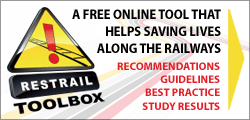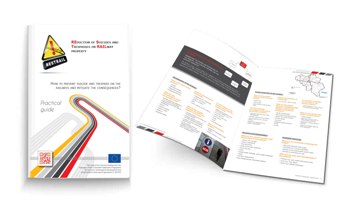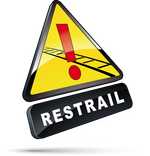Deliverables already submitted
- November 2014 - D5.2 - Evaluation of measures, recommendations and guidelines for further (...)
- September 2014 - RESTRAIL Toolbox
- September 2014 - RESTRAIL Practical guide
- July 2014 - D5.1- Selection of measures and their implementation in pilot tests planning and (...)
- April 2014 - RESTRAIL Newsletter Nr3
- June 2013 - RESTRAIL Newsletter Nr2
- February 2013 - merged D2.3 & 3.2 - Assessment of suitable measures (technical and soft (...)
- December 2012 - D.1.1 - Data concerning railway suicides and trespassing accidents (led by (...)
- September 2012 - D.4.2- Information, situation management and decision support platform, (...)
- July 2012 - Current knowledge of railway suicides and trespassing accidents (led by (...)
- June 2012 - D.4.1 - Consequences Mitigation information reference source (led by (...)
- May 2012 - RESTRAIL Newsletter Nr1
- December 2011 - D.6.1 - Dissemination plan (led by UIC)
- November 2011 - D.1.2 - Ethical framework (led by UIC)
- October 2011 - D.6.2 - Implementation of the collaborative tool (led by UIC)
The document D5.2 Evaluation of measures, recommendations and guidelines for further implementation takes part of the WP5, which works on the pilot tests. This paper has an objective to present an exhaustive analysis about the different piloted measures after their implementation.
This document collects the main results obtained from each evaluation of the piloted measures selected in WP5. Thus, the effectiveness of four of the evaluated measures targeted mainly suicides (Gatekeeper programme “train the trainers”; Dutch Gatekeeper programme, Societal Collaboration to prevent railway suicide and Mid-Platform fencing) can be found below; five targeted trespassing accidents (warning signs and posters; railway safety education programme; education at schools for 8-11 year old children; video enforcement and sound warning and a combination of measures at Ayden station and two measures aimed to mitigate the consequences by speeding up the system recovery from such incidents.
In order to know the results, a short description of the each one of the piloted measures is collected as well as the methodology used for the evaluation of the results. More information concerning these issues can be found in D5.1 Selection of the measures and their implementation in pilot test planning and execution (Kallberg, Plaza, Silla, García et al, 2014). In addition to this, two subsections are collected as well for each evaluated measure: applicability of the results to different circumstances and a discussion about the results obtained. Another important point is that a subsection about the cost benefit analysis for each implemented measure is included in the section of results of each pilot test.
Lastly, a set of general conclusions about the results gained for the evaluations can be found at the end of the document, as well as several recommendations.
| Link to the document |
The RESTRAIL Toolbox is a problem-solving guide for implementation of measures to prevent railway suicides and trespassing accidents and to mitigate the post incident consequences. It is the main output of the RESTRAIL research project and it aims to be a helpful, intuitive and user-friendly tool. It summarises practical information collected and produced during the project (synthesis, guidelines, best practice, lessons learned and empirical evidence for effectiveness). The content also makes links with scientific publications which support the recommended and promising measures, providing a wide list of references (research papers, research reports, reviews, etc.).
The Toolbox is designed to help railway undertakings (RUs), infrastructure managers (IMs), station managers and other concerned decision makers in three ways:
- lead them through the process of selecting from the range of preventative and mitigation measures,
- provide more detailed guidance on the implementation of those measures and
- provide a framework for collecting and structuring information in order to feed an accessible and documented database on measures for implementation and efficiency across the rail community and beyond.
| Link to the toolbox |
 |
| Link to the practical guide |
 |
The document D5.2 Evaluation of measures, recommendations and guidelines for further
implementation takes part of the WP5, which works on the pilot tests. This paper has an objective to present an exhaustive analysis about the different piloted measures after their implementation.
This document collects the main results obtained from each evaluation of the piloted measures selected in WP5. Thus, the effectiveness of four of the evaluated measures targeted mainly suicides (Gatekeeper programme “train the trainers”; Dutch
Gatekeeper programme, Societal Collaboration to prevent railway suicide and Mid-
Platform fencing) can be found below; five targeted trespassing accidents (warning signs and posters;railway safety education programme;education at schools for 8-11 year old children; video enforcement and sound warning and a combination of measures at Aydin station and two measures aimed to mitigate the consequences by speeding up the system recovery from such incidents.
In order to know the results, a short description of the each one of the piloted measures is
collected as well as the methodology used for the evaluation of the results. More information concerning these issues can be found in D5.1 Selection of the measures and their implementation in pilot test planning and execution (Kallberg, Plaza, Silla, García et al, 2014). In addition to this, two subsections are collected as well for each evaluated measure : applicability of the results to different circumstances and a discussion about the results obtained.
Another important point is that a subsection about the cost benefit analysis for each implemented measure is included in the section of results of each pilot test.
Lastly, a set of general conclusions about the results gained for the evaluations can be found at the end of the document, as well as several recommendations.
| Link to the document |
This Newsletter intends to keep you updated on the ongoing activities of the
RESTRAIL project.
| Link to the 3rd newsletter |
This Newsletter intends to keep you updated on the ongoing activities of the
RESTRAIL project.
| Link to the 2nd newsletter |
This deliverable aims to present the most suitable soft and technical measures to prevent trespassing and suicides on railway property.
The objectives of the work conducted were to assess these measures taking into account the experience of infrastructure managers, railway undertakings and other users.
The output from WP1 was a range of different preventive measures that had been identified as potential solutions across the world. By applying the methodology developed in tasks 2.1/3.1 ( D.2.1&D.3.1), different types of approach were classified and potential measures were compared and assessed. The assessment took into account factors and information that could impact the success of measures if they were applied in different European environments, and drew conclusions on a list of measures defined as recommended and promising.
Since measures geared towards preventing suicide cannot always be clearly distinguished from those aimed at preventing trespassing, and as those measures were reviewed and assessed using the same process, experts and criteria, the decision was taken to make the output from tasks 2.2, part of 2.3 and 3.2 a joint deliverable.
Discussions between experts and extended analyses and lessons learnt from participants’ experience have revealed and/or confirmed that for IMs and RUs, suicide and trespassing are problems that are addressed together.
| Link to the the methodology developed in tasks 2.1/3.1 | |
| Link to the Summary and conclusion of the deliverable |
The purpose of this deliverable is to provide a concise description of research conducted in work package 1 Qualitative analysis of suicides and trespass on railways properties and to present the conclusions drawn from the analysis of the collected data. The work resulted in the description of state-of-the-art based on literature review, up-to-date statistics on railway suicides and trespassing accidents compiled from different sources, analysis of the consequences of railway suicides and trespassing accidents, and data on the behaviour of victims prior to the incident.
| Link to the Summary and conclusion of the deliverable |
The objective of this work package is to develop methods and tools that can be integrated with existing procedures and technologies in order to achieve the most effective and cost-efficient means of mitigating the potential impact of train-pedestrian collisions (suicides, suicide attempts, trespasses, etc.) on railway infrastructures, as specified in D4.1.
This deliverable provides interested parties within the consortium and the European railway community with best-practice guidelines for the design and implementation of an information, situation management and decision support platform, focusing on the challenges of train-pedestrian collisions (suicides, suicide attempts, trespasses, etc.). By capturing relevant and meaningful information from a multitude of sources, analysing and correlating these silo inputs, valuable insights are gained through a complete situational awareness. The result will be a powerful pre-integrated solution that will allow railways to effectively and consistently manage and mitigate suicide attempt and trespassing incidents as they occur, becoming more proactive and sharing information efficiently for a collaborative response.
This document describes an information, situation management and decision support platform designed to mitigate the effects of railway suicides, suicide attempts and trespassing accidents, for use by European railway infrastructure managers and operators. The Situation Management system will cover every phase of incident management lifecycle, including planning, real time execution and post-event analysis and debriefing.
The objective of this document is to provide a systematic and critical description of current knowledge concerning railway suicides and trespassing accidents, and to describe and review the methods and tools that have been used for the prevention of such incidents. The analysis is based on scientific literature and research reports and on reviews of planned and ongoing relevant projects at national, European and global level.
| Link to the document |
The objective is to develop a functional information reference source that can be used by infrastructure managers, railway undertakings, police (state, municipal and railway), fire brigades and other first responders, regulatory and investigation bodies.
The reference source will serve these bodies in their response management and consequences mitigation actions, particularly with respect to the shut-down time of railway operation.
This document focuses on the "procedural" aspects associated with mitigating damage and resultant costs, resulting from attempted suicides, actual suicides and events in which trespassers on railway infrastructure are injured or killed. It does not deal with issues relating to prevention of suicide and trespass although clearly that is the first priority nor with post traumatic stress of involved railway personnel. These issues are considered in WP1, WP2 & WP3.
This Newsletter intends to keep you updated on the ongoing activities of the
RESTRAIL project.
| Link to the 1st Newsletter |
The objective of the dissemination plan is to raise the awareness of the RESTRAIL project as well as its outcome in order to make RESTRAIL a successful project with sustainable output.
Dissemination activities of RESTRAIL start at the very beginning of the project and will continue throughout entire duration.
Due to the importance of human aspects, (human factors, human behaviours, human decisions, human responses) within the topic of “suicides and trespass on railway property” addressed by the RESTRAIL, specific attention has to be paid to
ethical aspects.
The purpose of this ethical framework is to establish a set of principles and procedures to guide the partners to achieve the goals and objectives of the RESTRAIL project.
This framework outlines the obligations of each of the partners through all phases of
the project, from the collection of data to the publication and communication of the
experiences and outputs of the project
| Link to the document |
The main objective of this private area so-called “RESTRAIL workspace” or “extranet” is to facilitate communication among the consortium members, with European Commission
representatives as well as members of the advisory board and the end-users.
The “RESTRAIL workspace” is created in the new UIC collaborative tool “OVIDENTIA” which is an open source content management and a collaborative platform based on a large community of users.






